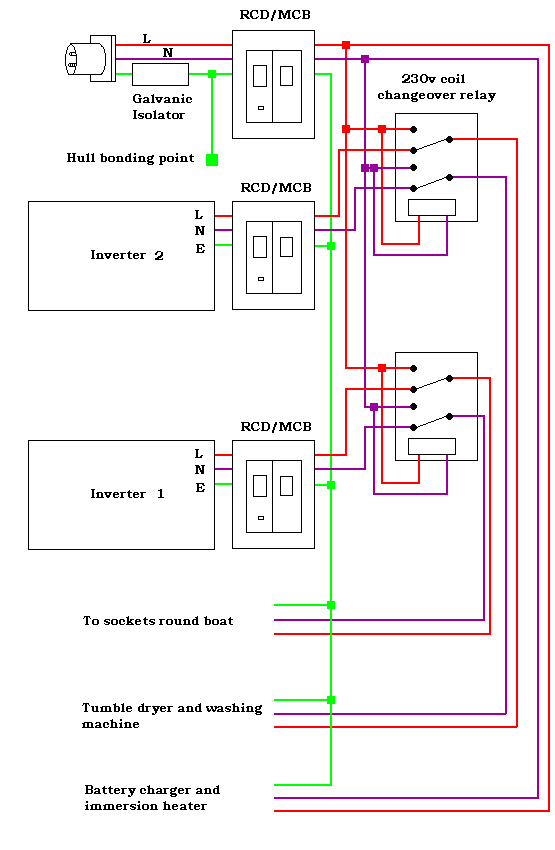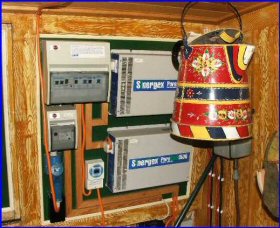What type of inverter ?
When I bought Lionheart it came fitted with a Mastervolt 1500 watt modified sinewave inverter. Whilst modified sinewave units do (despite some people's assertions to the contrary) still have their uses ours was not one of them. Despite what you may have been told, modified sinewave units ARE more efficient than pure sinewave units. If the intended equipment will run happily from modified sinewave units then it does actually make more sense to use that type. Especially now that, as everyone wants pure sinewave, modified sinewave units can be picked up for almost no money.
In our case we wanted to be able to use certain types of equipment that either doesn't work at all on a modified sinewave unit or does not perform up to full spec. One example of this is a microwave oven. They DO work on modified sinewave units but cooking time is longer (this is in addition to the problem of some microwave digital clocks running at twice, three times or four times normal speed when running from a modified sinewave unit).
We therefore opted to install a pure sinewave unit.
What size inverter ?
Many people become obsessed with installing huge inverters of say 2.5 to 3.5 KW. This is all very well but 2 questions have to be asked...
Firstly do you really have the recharging capacity to replace the level of battery charge that such a large inverter will use and....
Secondly, are you really intending to use such huge AC powered equipment that you actually need such a large inverter ?
Calculations (and experience) showed a 1500 watt unit was the ideal size in our case allowing us to use all the usual equipment such as TVs, videos, DVD players etc (these all use a few hundred watts in total), a hair dryer (typically 1600 watts - over 1500 watts but they aren't on long enough to cause a problem), vacuum cleaner (standard size units are usually around 1200 watts though we actually use a hand held Dirt Devil).
We also anticipated extensive use of the tumble dryer (studio size - only used whilst cruising or on shorepower) and washing machine. Now together these all add up to more than a 1500 watt unit can comfortably provide however, as I have said many times, if you rely on something so much that it would be a real pain to be without it then you should have 2 of them for backup in case of failure. Remember, if your inverter breaks, it's your problem. The bloke you bought it off doesn't care, and the bloke who will eventually fix it doesn't care. It's no good moaning at them because your single inverter failure ruined your holiday. They actually don't care. So we were going to be fitting 2 inverters anyway so it made sense to fit smaller ones and split the load.
We therefore have the following system...
2 x Sinergex Puresine 1500 watt inverters. One feeds the main AC system round the boat, the other feeds the tumble dryer and washing machine. Each has its own individual section in a split bus distribution panel. If we get a failure with one of the inverters we can simply reconnect the distribution panel internally as a temporary measure. This system is more versatile than using an inverter of twice the size and only marginally more expensive.
The Sinergex unit is a relatively new name but it's actually built by a company with many years experience of inverter design and manufacture. We first saw the unit as a result of a main UK importer sending us one to test. They send us a lot of equipment and ask for a full technical report and test before they will sell it. This is in order to maintain their quality standards. This unit immediately looked good. The build quality was excellent and performance truly astounding for the money (in fact truly astounding whatever the price was going to be). We have sold many, many units of this model (600 watt too but mostly the 1500 watt unit) and they have shown a much lower failure rate than ANY other inverter we have ever sold.
Since writing the above some time in 2003 we can change the above paragraph to:-
The Sinergex unit has now stood the test of time. We alone have sold several hundred of them and only had 2 failures. This is the lowest failure rate I have ever known for any inverter in my 20 years experience in the field. The price is still extremely competitive.
|
Lionheart's AC system. Twin 1500 watt sinewave inverters, Shorepower plug and galvanic isolator, shoreline voltmeter and reverse polarity indicator, Triple bus distribution panel (one bus each for shoreline and the two inverters) incorporating 2 automatic change over switches.
The time switch is for the electric immersion heater for when shorepower is available.
Just out of view is the 230 volt powered battery charger.
|
|
|
And finally the AC powered battery charger
The AC system is finished off with a third section in the split bus distribution panel fed from a shorepower socket which can then feed both the other (normally inverter fed) circuits (via an automatic changeover system inside the distribution panel) and also feeding a Statpower TrueCharge 40.
In between the shorepower socket and the main distribution panel is what looks like another small distribution panel. It is actually just the case of a small Wylex panel containing a voltmeter and reverse polarity indicator. From here it feeds into the main split bus panel.
The TrueCharge battery chargers are one of my all time favourite battery chargers. It's quite an old design now but was VERY advanced when it was first introduced in about 1988 being literally years ahead of the competition. Some other manufacturers are only just catching up with the design. It's probably the most bullet proof, rugged charger available. Very expensive but, as they say, you get what you pay for. Cheap chargers really are a false economy. Not only do they shorten the life of your batteries, they also don't charge them up properly. They also don't last very long. Would you rather pay £600 for a charger once and still have it 10 years later, or would you rather spend £150 every 18 months ?
Here is the wiring diagram of the AC system on Lionheart No 2 as of 02/07/2006

Web site and all contents Copyright SmartGauge Electronics 2005, 2006, 2007, 2008. All rights reserved.
Page last updated 02/04/2008.
Website best viewed on a computer of some sort.

